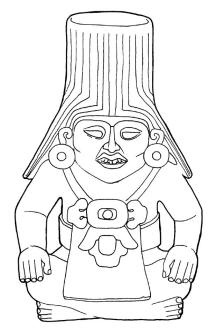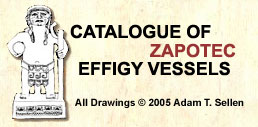| Key: MNA 6-6443 | | Actual Location: National Anthropology Museum, Mexico City, Mexico (exhibited). | | Registration: 6-6443 | | Provenance: Tomb 103, no. 33, Monte Albán, Oaxaca. | | Measurements: 35 x 24 cm. | | Color: Dark grey clay totally painted with red pigment, except for the conical hat whic | | Chronology: MA IIIB (Caso and Bernal 1952: 252); Peche 500 - 600 AD | | Click to view Chronology | | Reference: Caso 1938: 72 & 74, fig. 91; Caso & Bernal 1952: 119-120, figs. 185-186; Romero 1958: 220, plate XLVI; Gendrop 1970: 139, fig. 160; Carmona 1995: 165, fig. 4. | | Comments: This piece was excavated by Caso in their sixth field season (1937) and was found at a few centimeters from the South wall of the tomb. There were three other effigy vessels in the chamber and two burials (see pieces MNA t/103 1 and 3). Caso and Bernal (1952: 119) use this piece as an archetype of the effigy vessels known as "companions" (accompanying pieces). | | Glyphs: Pectoral (glyph for corn field) decorated with glyphs for corn grain. | |
| | 
Click to view high resolution in a new window
select this image for review |
